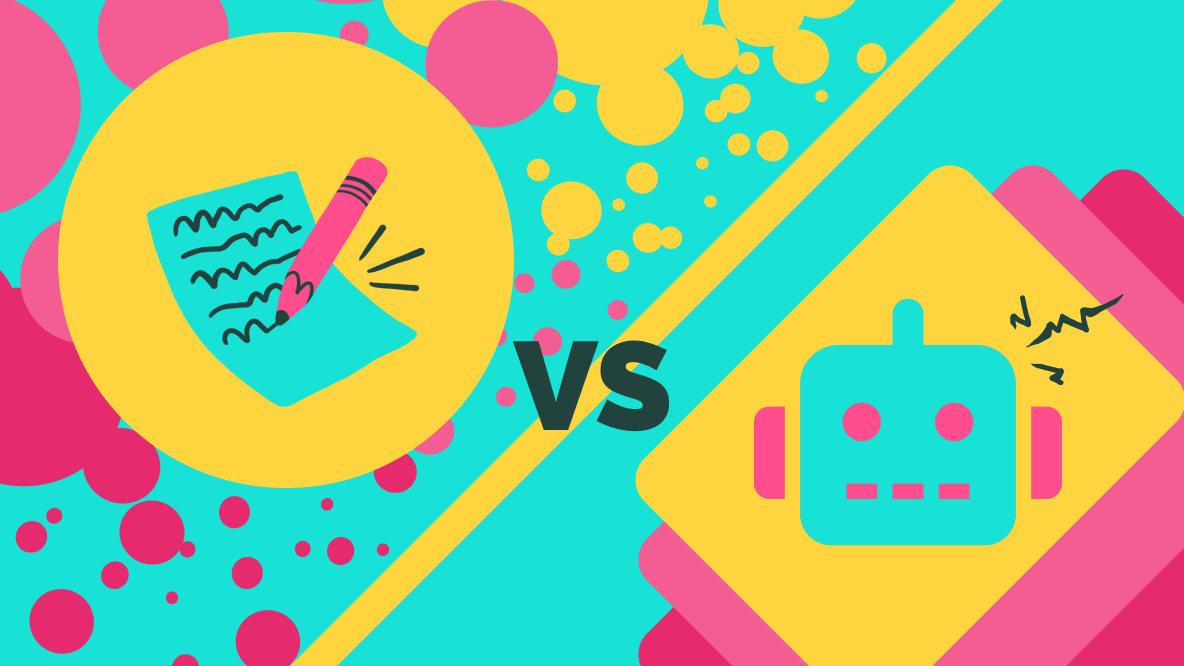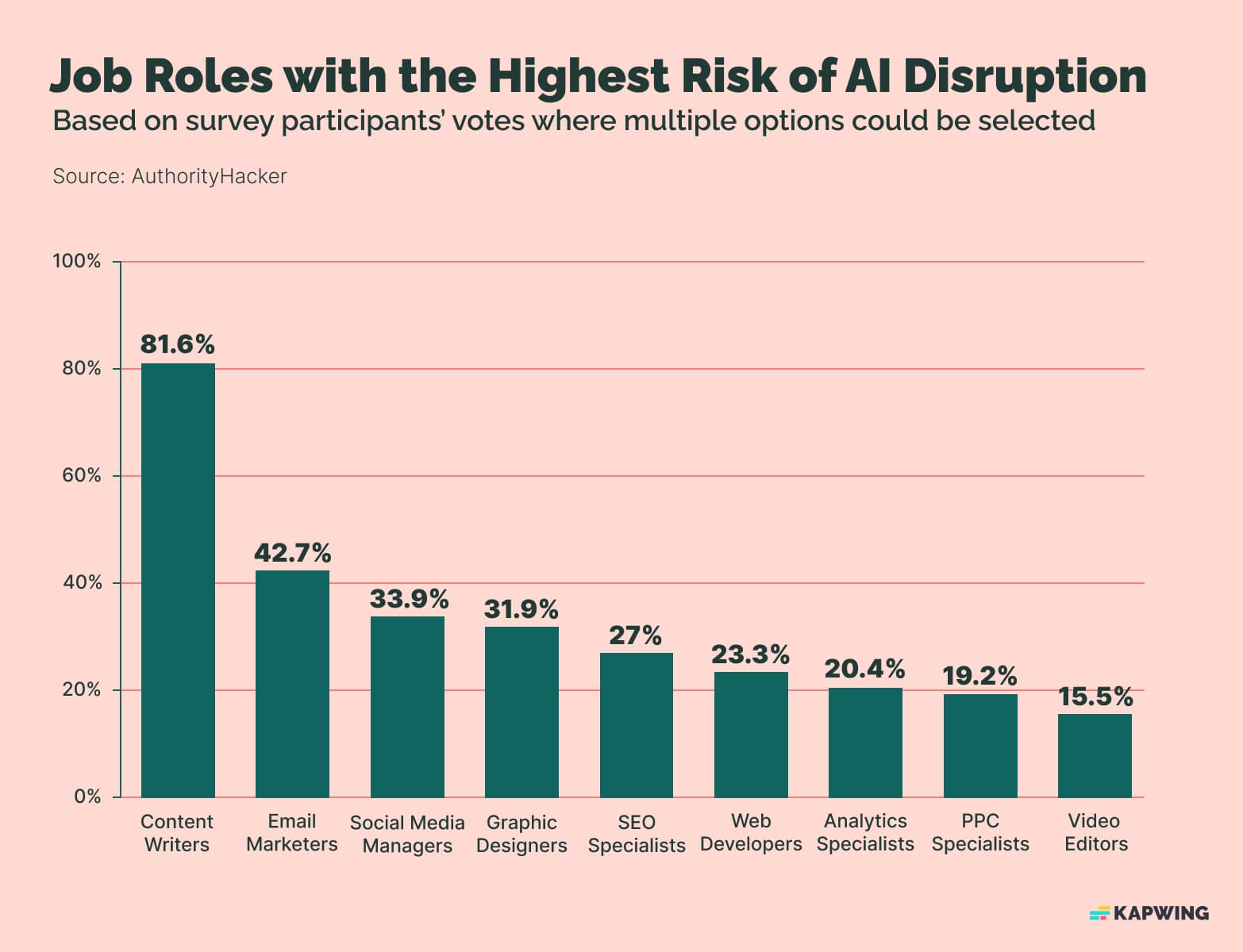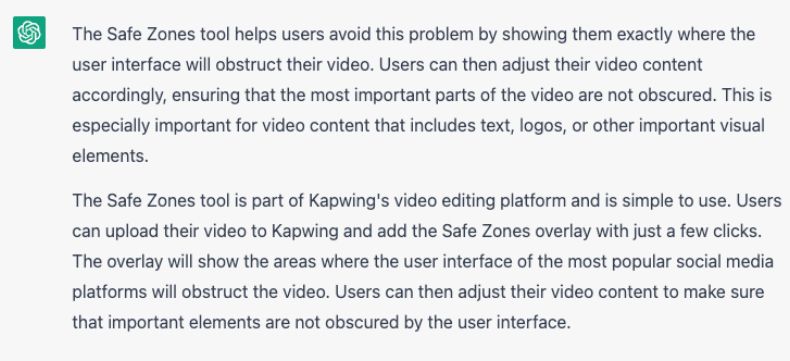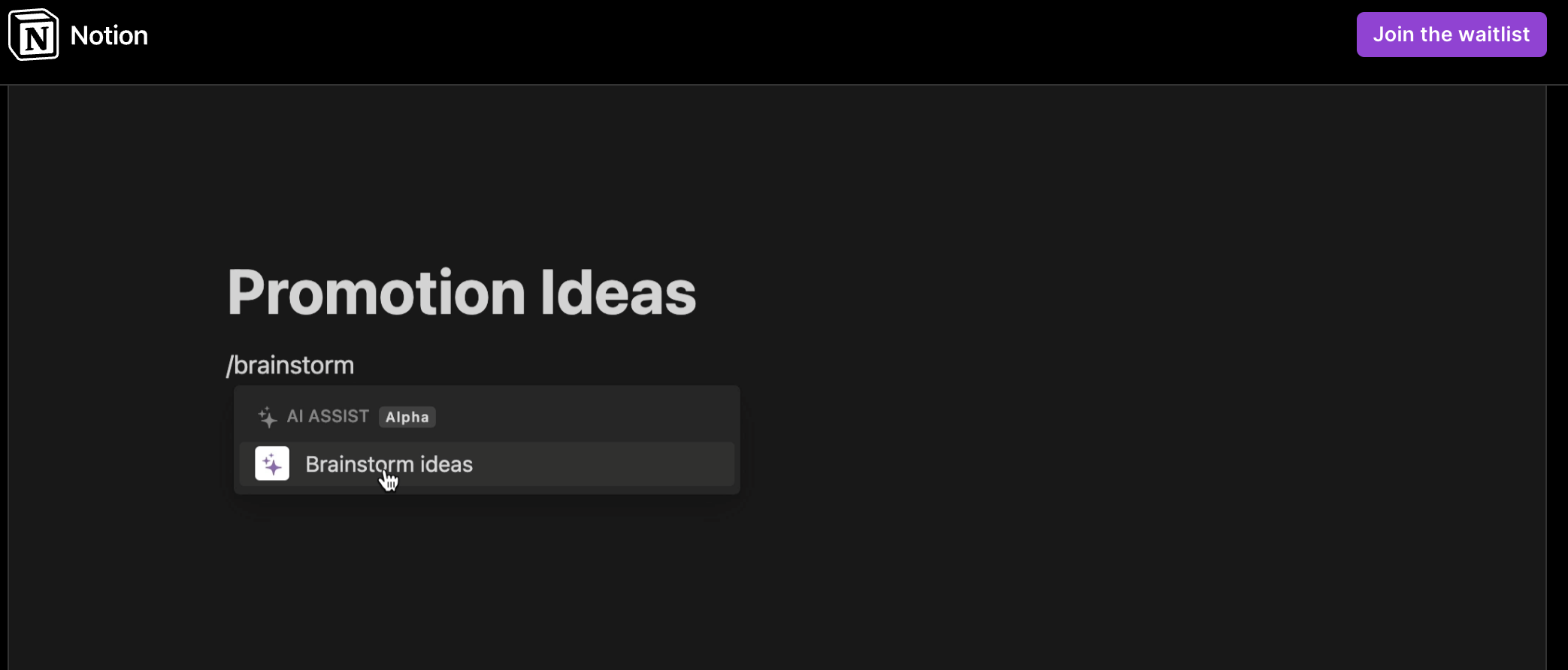Will AI Take Over Content Writing Jobs?
AI is making waves in the content writing community and not necessarily in a good way. In this article, I'll share some of what we predict will be coming for content writing and how to stand out in the flood of AI-generated writing.

Seems like ChatGPT has been on everyone's mind (and TikTok feeds) lately. For a lot of people, it's just a fun tool to play with. But for people who make their living by generating content, specifically written content, ChatGPT has potentially opened Pandora's box.
While AI video generators are definitely getting better, the real area where AI has emerged as a powerhouse seems to be text generation.
If you can generate whole blog posts, video scripts, and even picture books with it, are we in danger of losing our jobs?
You're not alone in wondering that. In fact, Content Writer tops the chart of jobs that could be at risk for AI Disruption according to this recent study.

A quick note: This is just perceived risk, as reported by professionals in the industry, not a prediction model of what's to come. However, this does give us good insight into how people are feeling about this AI industrial revolution.
And this question of AI disruption in the content writing market feels even more relevant and fraught with the recent announcement from media giant Buzzfeed:
Coming on the heels of Buzzfeed laying off 12% of their staff in December 2022, this announcement went over like a lead balloon in the journalist and writer communities, as you might expect.
Dotdash Meredith just laid off 274 employees + chatGPT is taking over writing jobs at BuzzFeed (and who knows where else). After 23 years jn this industry I adore, I’m watching it implode and I’m so sad.
— Jill Schildhouse jillschildhouse.substack.com (@JillSchildhouse) January 27, 2023
I originally set out to write this article with a pretty solid thesis: No, I don't think content writing jobs are at significant risk. And I had some data to back that claim.
But in the wake of this new information, that thesis feels flippant, and, to be honest with you, untrue. Especially when you take into account the way the market reacted to Buzzfeed's announcement.
market reaction to companies integrating chatgpt reminds me of the 2017 crypto hype. buzzfeed stock is up 150% in one day after announcing they’ll use chatgpt to write articles. pic.twitter.com/xsEtM99Y8q
— Munya (@raadzzi) January 26, 2023
With a +150% jump in Buzzfeed's stock, it seems plausible that other companies may try to ride this wave, too, and grab some of that interest from investors for themselves. Which reiterates the question: Are we all going to get replaced by AI?
No.
Or at least, not all of us.
The reality is that some written tasks are better suited to being outsourced to an AI than others. But there are still things that we do better as human writers. Good brands and publications should be able to discern the difference and staff accordingly. As a writer, I think the key is to focus on what you bring to the table as an individual that differentiates your work from that of an AI.
I've spent the last couple of months using ChatGPT and a few other AI writing assistants to see how they can augment the content writing process as well as where they tend to fail. (Yes, I see the irony — testing out the technology that might one day replace me.)
In this article, I want to share what I've learned from that experiment and the areas I think content writers should focus on to stand out in a sea of AI-generated writing.
First though, let's take a look at what our robot competition does well.
Why Do Businesses Use AI for Content Writing?
The most obvious use case for AI-powered content writing is, of course, to boost efficiency. Products like Jasper.ai claim that they help teams create content ten times faster.

"Ten times faster" is probably a stretch, but AI certainly speeds things up.
Longer articles take hours of my time to research, organize, and write. Using AI and machine learning powered tools, I was able to take an article from idea to publication in about an hour and half. And a good third of that time was spent learning how to talk to the AI to get the output that I wanted.
Here are the three main areas where I found AI tools sped up my workflow the most:
- Brainstorming ideas for our content calendar
- Organizing my thoughts into an outline
- Quickly researching a topic and synthesizing information
These are all very helpful when trying to optimize your content production, especially if you're part of a small marketing team (👋 hi, it's me, a member of a small marketing team). And if Kapwing published mostly listicles and short articles about static, evergreen topics, this would probably be enough to do my job for me.
But we tend to publish on trending topics, report on new formats and platforms, and dive into deeper issues affecting content creators.
So, now we get into where the gaps are with AI writing tools and how content writers are still needed to fill them.
Here are three areas where content writers can bring more to the table than AI:
1) Going In Depth About a Product
Unless you feed it pages and pages of product marketing copy, which you can't really do with chat-based models, an AI-powered writing tool is only able to provide vague, generalized information about a product specific to your brand. Because it's mostly guessing.
This may be less true for larger and more established brands, of course, about which there is plenty of information available online that the AI has likely already been trained on. But for smaller brands and start ups, it's not going to do the trick.
I asked ChatGPT to write an article about Safe Zones, the Kapwing tool that shows you how your video would look on TikTok, Reels, and YouTube Shorts. It provided a pretty decent explanation for why it's important to know the "safe zones" of a social media platform's interface:

The writing is a little clunky, sure, but the information's all correct.
Its description of how Safe Zones works, though, is lacking:

This description is somehow both repetitive and vague. The opposite of the concise, clear, action-oriented product marketing copy that you should strive for.
It also leaves out key features about the tool, like how it resizes content automatically, because it doesn't know anything about Safe Zones except what I've told it. ChatGPT is just inferring what the tool does from its name and the prompt I gave it.
You can get around some of this by providing more context in the prompt (and with some strong editing chops). But what if you want to write a tutorial about how to use your product?
We write a lot of tutorials here at Kapwing, showing readers how to do specific things with the various tools included in our editor. ChatGPT can write a general article about how to turn a YouTube video into a TikTok. But it isn't going to be able to write a tutorial about how to do that using Kapwing.
When I asked it to, it got some things right, but got a lot wrong.

Some of that wrong stuff was outdated info (remember, ChatGPT currently only has access to data it was trained on, which was all compiled by the end of 2021).

Some of it was just plain incorrect. Mostly, though, the tutorial felt thin and incomplete.
And that's because ChatGPT can't use Kapwing and record the step-by-step process for turning a YouTube clip into a TikTok. But guess who can?
Me. A human writer.
2) Reporting on News, Trends, and Emerging Topics
This seems self-explanatory. Machine learning only knows what it's been taught, right? So, it's limited when it comes to researching and writing about actually new information. AI isn't going to be able to report on current events or write an article about the latest crazy thing Twitter's doing.
That makes sense.
The nonobvious piece here is that not only can AI not write about these emerging topics, it can't predict or find them, either. And a lot of companies are sizing up AI as a potential tool for content strategy, too, not just content writing.
Consider Buzzfeed's announcement that I mentioned earlier, or this new tool from Notion that's marketed as a brainstorming assistant.

There are plenty of think pieces out there about how to use ChatGPT to fill your content calendar. It's all over TikTok and we've even talked about it.
But when we actually iterated on the topic ideas that ChatGPT gave us, the results weren't great.
I asked ChatGPT for article topic recommendations for a video software company's blog (aka what you're reading right now). It recommended a topic about how to film and edit B-roll footage. I then used a combination of AI writing tools to write the post and published it to our site:

It... didn't perform well.
Compare that to the traffic on a trend-spotting article I wrote around the same time:

That's about 20,000% more traffic than the first article. Sure, the first article took less time to write because I was using AI, but not 20,000% less time.
If you're going to use AI to help fill out your content calendar, I recommend augmenting that strategy with some solid SEO research. Especially if you rely on traffic boosts and backlinks from spiky, trending content. ChatGPT and similar tools can't predict what's going to pop off.
Of course, when Google's AI search competitor rolls out that might change, but for now, double check your AI-generated homework before turning it in.
3) Providing Original Insights and Human Perspective
AI can do a pretty convincing job mimicking tone and voice if it's been fed enough data to learn from. But it can only synthesize existing information, not form opinions, share thoughts and feelings, or run experiments to discover new information.
![Screenshot of a ChatGPT conversation. The prompt reads: "Write a podcast script in the voice of Ira Glass reporting for "This American Life" talking about the Iowa State Fair butter sculptures." The response reads: "[Intro music plays] Ira Glass: Hi, this is Ira Glass and you're listening to This American Life. Today we're talking about one of the most unique and beloved American traditions: the Iowa State Fair butter sculptures. [Sound of the fair - crowds, carnival music, etc.] Ira Glass: Every year, thousands of people come from all over the country to visit the Iowa State Fair, where they're greeted by an amazing display of butter sculptures. These sculptures, made entirely out of butter, are a staple of the fair and are among its most popular attractions."](https://www.kapwing.com/resources/content/images/2023/02/Ira-Glass-butter-sculpture-example-chatgpt.png)
Take the above example: a script for an episode of "This American Life," hosted by Ira Glass.
AI can mimic Ira Glass's style of speech because there are thousands of hours of "This American Life" archived online that make up part of the data it was trained on. It can also talk confidently (and probably correctly) about the tradition of butter sculptures at the Iowa State Fair, because that's all available online, too.
But it can't interview Sarah Pratt, the artist who's been sculpting the butter cow since 2006. Nor can it ask the animal rights activists involved in the 2013 vandalization of the cow about the message they were hoping to spread. It can synthesize clips and bits from existing interviews with those people into something approximating reality, but that would still be very much fiction and not actual reporting.
You're not Ira Glass, of course (unless you are, in which case, hi! big fan). But there's a takeaway here even if you're writing for a corporate blog or company resources library. Authorship and the ability to prove it is likely going to become valuable currency as AI reshapes the content creation landscape.
People will be looking for proof that things are written by humans.
To get a head start on standing out in the sea of AI-generated content to come, companies should start leveraging their in-house talent as topic experts now, leaning into unique voice and personality. Yes, that probably means writing your corporate blogs in the first person (it'll be okay, I promise).
What Content Writing Looks Like Going Forward
The truth is that the rise of AI-powered content writing is a deeply complex and sensitive topic.
It would be both callous and untrue to say that AI isn't a threat to our content writing jobs. But the good news is that there are certain types of content writing that aren't replicable by AI yet — like in-depth product marketing copy, journalistic reporting, and original research and insight.
As for the rest of it, I recommend getting good at writing AI prompts and editing AI-written copy. Because it's not going away.
For more articles like this, check out our Resources Library. We (a team of human content creators) publish new posts every week on relevant creator topics, tips, and trends.
Related Articles:
- AI Video Creation vs. Editing with Video: What's the Difference?
- Everything You Need to Know About AI for Social Media
- 5 AI Trends That Are Reshaping Technology









